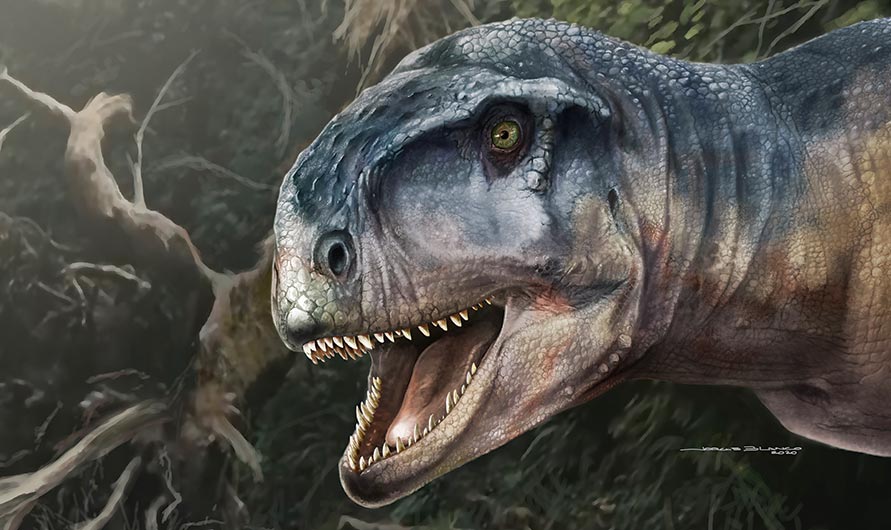New Dinosaur Named 'One Who Causes Fear' Likely Sensed Prey with Keen Ears and Nose

An artist's impression of the new dinosaur, Llukalkan aliocranianus.
Jorge Blanco and Journal of Vertebrate Paleontology
(Inside Science) -- A newfound dinosaur was likely as long as an elephant and was equipped with an extremely powerful bite, very sharp teeth, and huge claws on its feet, researchers say.
In the dry Patagonian plains of Argentina, scientists unearthed 80-million-year-old fossils of a dinosaur they estimated could reach up to 5 meters long. The researchers named the carnivore Llukalkan aliocranianus. "Llukalkan" means "one who causes fear" in the language of the Mapuche people native to the area, whereas "aliocranianus" is Latin for "different skull."
Llukalkan was one of nearly 20 known giant predatory species known as abelisaurids. With their powerful legs and stubby arms, abelisaurids resembled tyrannosaurs, except they had unusually short, deep skulls that often bore crests, bumps and horns -- a bit like some modern reptiles such as the Gila monster or some iguanas. Whereas tyrannosaurs ruled the Northern Hemisphere, abelisaurids prowled mainly in the ancient southern subcontinent Gondwana, which now makes up Africa, India, Antarctica, Australia and South America.
The new fossils included an extraordinarily intact braincase, which revealed that Llukalkan likely had a keen sense of smell. The dinosaur also possessed a small air-filled cavity within its middle ear not seen in any other abelisaurid unearthed so far, which suggests Llukalkan likely had a stronger sense of hearing than most other abelisaurids, one similar to that of a modern-day crocodile. These sharp senses "would have given great capabilities as a predator to this species," said study lead author Federico Gianechini, a paleontologist at the National University of San Luis in Argentina.
Llukalkan's bones were buried by mud from overflowing rivers, likely due to seasonal floods. Other dinosaurs that lived in the same areas included plant-eating, long-necked, long-tailed titanosaurs that reached about 10 meters long, "which were surely prey of Llukalkan," Gianechini said.
Llukalkan lived in roughly the same time and place as an even larger abelisaurid, Viavenator exxoni. When these carnivores were alive, they were likely the top predators in this area, and perhaps all Patagonia, the scientists noted.
The anatomical novelties seen in Llukalkan suggest abelisaurids were flourishing not too long before the end of the age of dinosaurs about 67 million years ago, trying out new evolutionary pathways and rapidly diversifying before they died out, the researchers said.
The scientists detailed their findings online March 30 in the Journal of Vertebrate Paleontology.

